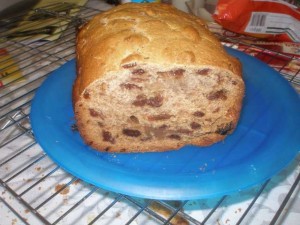Lincolnshire Plum Bread
[If a Lincolnshire publication would like to reprint this, just contact me!]
Lincolnshire is famous for several kinds of food. There is Lincolnshire Poacher Cheese – a sharp, biting cheese, Lincolnshire Sausage – a sausage seasoned with herbs, and another famous Lincolnshire food item is Lincolnshire Plum Bread.
No one seems to know exactly when people started making Plum Bread, other than that it is “centuries old”. Several local bakeries that have been in business since the early 20th century claim Plum Bread as one of their first specialities, so we do know that Plum Bread has been around for at least over 100 years, possibly even 200 or 300.
We also know that “plum” doesn’t refer to plum fruits or even to prunes (dried plums). “Plum” simply is a reference to dried fruit, such as calling a Christmas Pudding a “Plum Pudding”. The word “Plum” for dried fruit originated during the Middle Ages, when dried fruit was used to help preserve meat. This type of preservation continued and the recipe was modified into what we now call a Plum Pudding or a Christmas Pudding.
The use of the word “bread” to describe this food item is a bit of a misnomer as well. You wouldn’t want to use this for sandwiches. Lincolnshire Plum Bread is traditionally served at breakfast time or tea time. In medieval England, the words “bread” and “cake” were used interchangeably, and they still are today. Take for example, banana bread. Banana bread is surely more closely related to being cake, yet we call it a bread. Banana bread did not formally enter kitchens until the 1930s in America, though there is speculation that it may have been invented in the late nineteenth century by American housewives. Either way, it’s still a long way away from medieval England when either word could be used.
If Lincolnshire Plum Bread is not a bread and does not actually have plums, what is it? Lincolnshire Plum Bread is a sweet, almost cake-like cinnamon-flavoured bread with dried fruit in it – sultanas, currants, and fruit peel – that has been soaked in cold tea to help the dried fruit “plump” up.
There are several bakeries in Lincolnshire that claim to be “the original”, but perhaps the most famous brand is Myers. in 1977 a loaf was given to the queen at her silver jubilee and Myers Lincolnshire Plum Bread is served on British Airways in their first class cabin. Other brands also exist and the loaves retail for about £2.50. You can purchase Lincolnshire Plum Bread throughout Lincolnshire in small bakeries and at the co-op.
If you’re outside of Lincolnshire, hope is not lost. There are many recipes floating around on the internet for Lincolnshire Plum Bread, and I will include my own recipe, modified for a bread machine, below.
Lincolnshire Plum Bread
First, you will need some cool strong tea. The easiest way to do this is to take a glass measuring cup, put 2 tea bags in it, and fill it halfway with water from the kettle. Then, forget about it for about 5 minutes and let it get nice and dark. Remove the tea bags and add cold water to cool it down quickly.
Add about 300-400g dried fruit (sold in grocery stores as “dried mixed fruit” or use a combination of dried currants, sultanas, raisins, and peel) and let it sit until the fruit is nice and plump.
Meanwhile, get out your bread machine and add to it:
100g butter (melted)
120ml warm milk
2 eggs
450g bread flour
100g sugar
1 tsp cinnamon
1 tsp allspice
1 1/2 tsp bread machine yeast
Follow the instructions on your bread machine for what order you should add ingredients. Mine calls for all the liquid to go in first, which includes the eggs. I also save time by microwaving the butter and milk together – an extra bonus is it keeps the butter from exploding all over the microwave.
Set your bread machine to a 1KG loaf (2lbs), medium crust, and use the sweet setting (on my machine, this is setting 4).
Start your bread machine.
Follow your machine’s instructions for adding fruit. Most machines will beep when they want you to add fruit, so wait for the beep, drain off the tea, and pour in the fruit. You might need to keep an eye on it for a few minutes and use a spatula to make sure all the fruit gets mixed in.
Let the bread cool in the pan for about 20 minutes before turning out. I find it’s easier to cut the bread if I let it cool completely, but by all means serve it warm!
Traditionally, Lincolnshire Plum Bread is served with butter and cheese. Give it a try, you might like it!
This bread has the seal of approval from several Lincolnshire born & raised men and women! 😀
[LJ readers reading this on the LJ RSS feed: Please click on the link at the top of the entry to go directly to my blog to leave a comment, as comments left on the LJ RSS do not get seen by me. Facebook users can comment directly on Facebook.]
2 comments2 Comments so far
Leave a reply



I tried my first slice of Plum Bread in a little tea shop in Lincoln. We were all there to do a bit of family tree hunting. It seems that most are from Lincolnshire and Yorkshire. The highlight of the trip was the bread. I have tried a few recipes… yours will be next!
Spb 🙂
I hope you enjoy it!